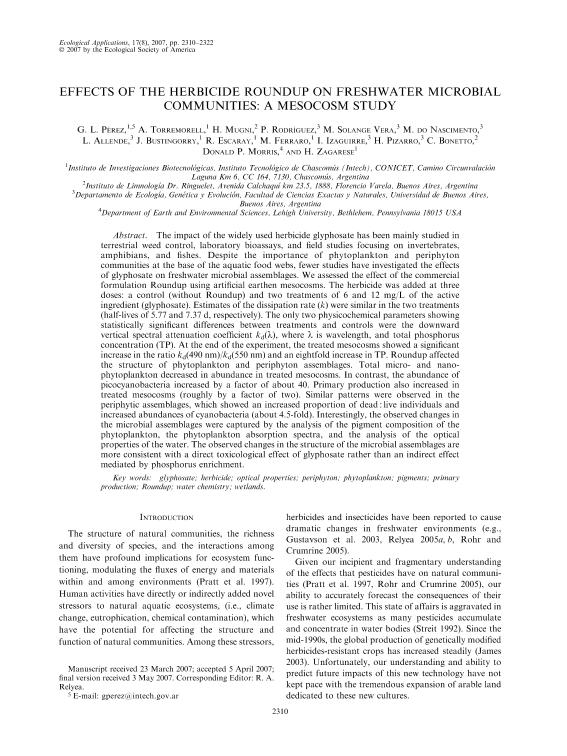Mostrar el registro sencillo del ítem
dc.contributor.author
Pérez, Gonzalo

dc.contributor.author
Torremorell, Ana María

dc.contributor.author
Mugni, Hernan Diego

dc.contributor.author
Rodriguez, Patricia Laura

dc.contributor.author
Vera, Maria Solange

dc.contributor.author
Do Nascimento, Mauro

dc.contributor.author
Allende, Luz

dc.contributor.author
Bustingorry, Jose Fernando

dc.contributor.author
Escaray, Francisco José

dc.contributor.author
Ferraro, Marcela Andrea

dc.contributor.author
Izaguirre, Irina

dc.contributor.author
Pizarro, Haydee Norma

dc.contributor.author
Bonetto, Carlos Alberto

dc.contributor.author
Morris, Donald P.
dc.contributor.author
Zagarese, Horacio Ernesto

dc.date.available
2017-12-15T17:25:16Z
dc.date.issued
2007-12-01
dc.identifier.citation
Zagarese, Horacio Ernesto; Morris, Donald P.; Bonetto, Carlos Alberto; Pizarro, Haydee Norma; Izaguirre, Irina; Ferraro, Marcela Andrea; et al.; Effects of the herbicide Roundup on freshwater microbial communities: a mesocosm study; Ecological Society of America; Ecological Applications; 17; 8; 1-12-2007; 2310-2322
dc.identifier.issn
1051-0761
dc.identifier.uri
http://hdl.handle.net/11336/30764
dc.description.abstract
The impact of the widely used herbicide glyphosate has been mainly studied in terrestrial weed control, laboratory bioassays, and field studies focusing on invertebrates, amphibians, and fishes. Despite the importance of phytoplankton and periphyton communities at the base of the aquatic food webs, fewer studies have investigated the effects of glyphosate on freshwater microbial assemblages. We assessed the effect of the commercial formulation Roundup using artificial earthen mesocosms. The herbicide was added at three doses: a control (without Roundup) and two treatments of 6 and 12 mg/L of the active ingredient (glyphosate). Estimates of the dissipation rate (k) were similar in the two treatments (half-lives of 5.77 and 7.37 d, respectively). The only two physicochemical parameters showing statistically significant differences between treatments and controls were the downward vertical spectral attenuation coefficient kd(λ), where λ is wavelength, and total phosphorus concentration (TP). At the end of the experiment, the treated mesocosms showed a significant increase in the ratio kd(490 nm)/kd(550 nm) and an eightfold increase in TP. Roundup affected the structure of phytoplankton and periphyton assemblages. Total micro- and nanophytoplankton decreased in abundance in treated mesocosms. In contrast, the abundance of picocyanobacteria increased by a factor of about 40. Primary production also increased in treated mesocosms (roughly by a factor of two). Similar patterns were observed in the periphytic assemblages, which showed an increased proportion of dead : live individuals and increased abundances of cyanobacteria (about 4.5-fold). Interestingly, the observed changes in the microbial assemblages were captured by the analysis of the pigment composition of the phytoplankton, the phytoplankton absorption spectra, and the analysis of the optical properties of the water. The observed changes in the structure of the microbial assemblages are more consistent with a direct toxicological effect of glyphosate rather than an indirect effect mediated by phosphorus enrichment.
dc.format
application/pdf
dc.language.iso
eng
dc.publisher
Ecological Society of America

dc.rights
info:eu-repo/semantics/openAccess
dc.rights.uri
https://creativecommons.org/licenses/by-nc-sa/2.5/ar/
dc.subject
Glyphosate
dc.subject
Microbial Communities
dc.subject
Mesocosms
dc.subject
Water Quality
dc.subject.classification
Biología Marina, Limnología

dc.subject.classification
Ciencias Biológicas

dc.subject.classification
CIENCIAS NATURALES Y EXACTAS

dc.title
Effects of the herbicide Roundup on freshwater microbial communities: a mesocosm study
dc.type
info:eu-repo/semantics/article
dc.type
info:ar-repo/semantics/artículo
dc.type
info:eu-repo/semantics/publishedVersion
dc.date.updated
2017-10-30T18:58:37Z
dc.journal.volume
17
dc.journal.number
8
dc.journal.pagination
2310-2322
dc.journal.pais
Estados Unidos

dc.journal.ciudad
Washington
dc.description.fil
Fil: Pérez, Gonzalo. Consejo Nacional de Investigaciones Científicas y Técnicas. Centro Científico Tecnológico Conicet - La Plata. Instituto de Investigaciones Biotecnológicas. Instituto de Investigaciones Biotecnológicas ; Argentina
dc.description.fil
Fil: Torremorell, Ana María. Consejo Nacional de Investigaciones Científicas y Técnicas. Centro Científico Tecnológico Conicet - La Plata. Instituto de Investigaciones Biotecnológicas. Instituto de Investigaciones Biotecnológicas ; Argentina
dc.description.fil
Fil: Mugni, Hernan Diego. Consejo Nacional de Investigaciones Científicas y Técnicas. Centro Científico Tecnológico Conicet - La Plata. Instituto de Limnología ; Argentina
dc.description.fil
Fil: Rodriguez, Patricia Laura. Universidad de Buenos Aires. Facultad de Ciencias Exactas y Naturales. Departamento de Ecología, Genética y Evolución; Argentina. Consejo Nacional de Investigaciones Científicas y Técnicas. Centro Austral de Investigaciones Científicas; Argentina
dc.description.fil
Fil: Vera, Maria Solange. Universidad de Buenos Aires. Facultad de Ciencias Exactas y Naturales. Departamento de Ecología, Genética y Evolución; Argentina. Consejo Nacional de Investigaciones Científicas y Técnicas; Argentina
dc.description.fil
Fil: Do Nascimento, Mauro. Universidad de Buenos Aires. Facultad de Ciencias Exactas y Naturales. Departamento de Ecología, Genética y Evolución; Argentina. Consejo Nacional de Investigaciones Científicas y Técnicas; Argentina
dc.description.fil
Fil: Allende, Luz. Universidad de Buenos Aires. Facultad de Ciencias Exactas y Naturales. Departamento de Ecología, Genética y Evolución; Argentina. Consejo Nacional de Investigaciones Científicas y Técnicas; Argentina
dc.description.fil
Fil: Bustingorry, Jose Fernando. Consejo Nacional de Investigaciones Científicas y Técnicas. Centro Científico Tecnológico Conicet - La Plata. Instituto de Investigaciones Biotecnológicas. Instituto de Investigaciones Biotecnológicas ; Argentina
dc.description.fil
Fil: Escaray, Francisco José. Consejo Nacional de Investigaciones Científicas y Técnicas. Centro Científico Tecnológico Conicet - La Plata. Instituto de Investigaciones Biotecnológicas. Instituto de Investigaciones Biotecnológicas ; Argentina
dc.description.fil
Fil: Ferraro, Marcela Andrea. Consejo Nacional de Investigaciones Científicas y Técnicas. Centro Científico Tecnológico Conicet - La Plata. Instituto de Investigaciones Biotecnológicas. Instituto de Investigaciones Biotecnológicas ; Argentina
dc.description.fil
Fil: Izaguirre, Irina. Universidad de Buenos Aires. Facultad de Ciencias Exactas y Naturales. Departamento de Ecología, Genética y Evolución; Argentina
dc.description.fil
Fil: Pizarro, Haydee Norma. Universidad de Buenos Aires. Facultad de Ciencias Exactas y Naturales. Departamento de Ecología, Genética y Evolución; Argentina
dc.description.fil
Fil: Bonetto, Carlos Alberto. Consejo Nacional de Investigaciones Científicas y Técnicas. Centro Científico Tecnológico Conicet - La Plata. Instituto de Limnología ; Argentina
dc.description.fil
Fil: Morris, Donald P.. Lehigh University; Estados Unidos
dc.description.fil
Fil: Zagarese, Horacio Ernesto. Consejo Nacional de Investigaciones Científicas y Técnicas. Centro Científico Tecnológico Conicet - La Plata. Instituto de Investigaciones Biotecnológicas. Instituto de Investigaciones Biotecnológicas ; Argentina
dc.journal.title
Ecological Applications

dc.relation.alternativeid
info:eu-repo/semantics/altIdentifier/url/http://onlinelibrary.wiley.com/doi/10.1890/07-0499.1/abstract
dc.relation.alternativeid
info:eu-repo/semantics/altIdentifier/doi/http://dx.doi.org/10.1890/07-0499.1
Archivos asociados
